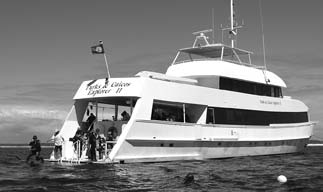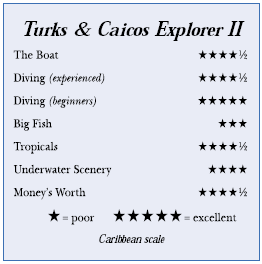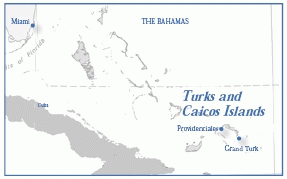Turks & Caicos Explorer IIContents of this Issue: How to Go Diving with Nondiving Kids New Luggage Limits Slam Traveling Divers Women Divers and Their Menstrual Cycles Unlucky Fiji Divers Poisoned by Dinner Dive Stores, the Internet and the Industry, Part IV Editorial Office: Ben Davison Publisher and Editor Undercurrent 3020 Bridgeway, Suite 102 Sausalito, CA 94965 the best of the Caribbean from the August, 2006 issue of Undercurrent
Dear Reader: Perhaps the definition of a perfect liveaboard trip is that everything happens exactly as you expect, from the time you step on board until the time you debark. Now, I’d dived the Turks and Caicos Islands before and knew to expect excellent Caribbean diving -- nothing high voltage, but plenty of fish, beautiful walls and nice seascapes. Having been on 15 liveaboards and done my homework on the T&C Explorer II, including consulting the Chapbook, I expected a fine dive boat. As it turned out, I got what I expected from the boat and diving. However, when considering “perfect,” I’d better include what happened before I stepped on and after I stepped off.
It was an annoying first day. Upon arrival, Providenciales (Provo)immigration officials now photograph everyone, which not only slows entry to a crawl but makes travel reminiscent of cold war Europe. Sixteen Explorer passengers had been on the flight from Atlanta. Once we stepped outside the terminal into the blistering May heat, we were greeted only by the driver of a single eight-passenger taxi –- and with no Explorer crew member to facilitate logistics (the first time in all my liveaboard trips that happened). It was 2:00 p.m. and since the brochure says it would be a 3:00 p.m. boarding, I figured we’d go directly to the boat. Nope, they had instructed the cab driver to take us in shifts, at $6/ person, to a restaurant, to wait. The restaurant was closed for a private party. So, to cool our heels, eight of us ambled to an adjacent restaurant in the marina where the Aggressor docks, for a cold beer. The other passengers hung at the airport until the van returned to cart them off to a different restaurant. Meanwhile, luggage was left piled on the airport sidewalk, guarded only by a child, until the van driver returned to pick it up. That works in Provo. Try it in Atlanta. Later, it was a $10/person cab ride to Sapadilla Bay (I figure the driver raked in $300 for an afternoon’s work), and sometime after 5:00 p.m. we climbed into a dinghy on a sand beach to be shuttled to the dive boat. Our luggage had already been delivered to our cabins, and drinks and dinner were forthcoming. Orientation and paperwork followed, and I was ready to crash after the long and tedious day. Mornings starts early on dive boats. I was up by 6:00 a.m. and poured myself a cup of hot coffee in the galley, ignoring the continental breakfast in favor of the full buffet 7:00 a.m.: eggs cooked to order and daily specials such as ham, bacon, French toast, pancakes or eggs Benedict. Over breakfast I learned that four Steves and three Johns were on board. (Names give some idea when people were born; no Ethans, Jacobs or Joshuas on this trip.) After breakfast, purser Van Vandermeulen reviewed the dive procedures, explaining that divemasters Steve Main and Hester Biijieven would describe each site, sketch the profile and list items of interest. One crew member would always be in the water to point out creatures or become a buddy for anyone wanting one. Other than diving with a buddy and staying above 130 feet, everything you did was your call. After breakfast –- we had to wait for an A/C repair -- the Explorer moved
to the Crack at Provo’s Northwest Point, arriving late so we missed the first
dive. Here the wall starts at 45 feet and seems to plunge to infinity. We motored an hour to West Caicos for an afternoon and evening dive, and stayed in the area two more days. Here is the best Provo-area diving, and with four day dives and a night dive daily, we had the advantage over divers who come by day boat from Provo. The wall starts at 50 feet, and swimming alongside with blue water around and below is breathtaking. Barrel and elephant ear sponges are prolific, and giant sponges, a sheer wall, and soft and hard corals beckon wide-angle lenses. Common tropical reef fish, such as queen and gray angels, abound. I usually had my head in a crack looking for small stuff, so I saw only a few eagle rays, but back on the boat I’d hear divers’ tales of more. On nearly every dive I saw blacktip, nurse or reef sharks. A school of horse-eye jacks hung under the boat on most dives, making for interesting safety stops. In sandy areas, I saw garden eels, jawfish, gray stingrays and flying gurnards, and once the divemaster pointed out a startling white frogfish. For photos, I loved a 17th-century anchor wedged in the side of a gully, with one fluke extended. I got fine images of a green moray and a scorpion fish on the ledge next to the anchor. A turtle swam up to three different divers. Why? Only she knows. The CEII is a comfortable craft with roomy cabins, an adequate lounge and eating area, a large sun deck and an open-air lounge on the top deck. Each cabin has its own head and shower and either a queen or twin beds. Although cabins have individual A/C controls, mine didn’t work and neither did the purser’s. He said just to turn it on when you get hot and off when you get cold. Inconvenient, but it worked. The dive deck has plenty of individual room as well as two hot water showers. Stow fins, masks and other gear beneath your seat; hang wet suits from center racks. Two aisles with opposing seats lead to two stairways to an easy-entry dive platform. To respect my aching back, I got help from the crew to get my tank to the platform. When I exited, the crew also helped by supporting the tank’s weight while I walked three steps to the platform bench. They offered help without a reminder and were always cheerful about it. The passengers on this trip ranged in age from mid-30’s to more than 80 years old. Half were older than 60. There were arthritic knees. Two divers had had back surgery. Another was aboard six months after abdominal surgery. The Explorer crew would tote tanks to and from the dive platform and help us don our tanks. We could stay seated and roll in or stand up and giant stride. The dive ladders are constructed at a proper angle, have good steps and railings as well, and the crew makes an exit easy. Leaded hang lines on each side of the dive platform drop 25 feet, making it easier to accommodate more divers and more gradual ascents than standard 15-foot lines. The crew recorded the times each diver entered and exited the water, the dive depth and remaining PSI. While they constantly monitored the surface as long as divers were in the water, they once watched two divers exhaust themselves swimming against the current to get back to the boat. The divers didn’t call for help -- a bit too much pride, I think -- but it was clear they would have relished a tow and it should have been offered. Another time the staff watched a couple struggling in a current to reach the tag line. After I nagged, they tied a length of rope to the line and pulled in the divers. They must remain mindful that liveaboard passengers these days are not all spring chickens. Stan Simmons is from the Turks and Caicos and has been creating meals on local liveaboards since the Sea Dancer started plying the area 20 years ago. His meals continue to get high marks, though some had too much heat for me. Lunches included sandwiches, soup, salad and pasta. One day we had grilled burgers and another day, tacos and wraps. Dinners offered a selection of salads and vegetables and a different entree daily, such as pork loin, fish, barbecued ribs or turkey with all the fixings. Stan even served at the buffet line to keep the food coming. His big smile and colorful shirts lit up the lounge. I told Stan that I am allergic to green and red peppers, so he added yellow peppers to many dishes. I couldn’t handle those, so he prepared special dishes just for me. Due to its isolation and lack of protection, French Caye is not always reachable,
so dive boats seldom visit. At West Sand Spit, five miles south of French Caye, we had flat, calm seas and the only significant tidal currents of the trip. On the second dive, the current was so strong I had to crawl along the bottom gripping coral until I reached the anchor line. I ascended 20 feet to grab it, then let go to fly to the hang line. Before the fourth dive, the hang lines were lifted by the current to a 30-degree angle behind the boat. I asked the captain whether the current was too strong to dive, so engineer Steve Sutek jumped in. After a hand-over-hand return on the float line, he reported it was undiveable, and we returned to French Caye. Friday morning, some divers made a dawn dive into dark waters; then came the last dive at 8:30 a.m. During the three-hour trip back to Provo, I washed gear and packed up. We anchored in the bay midafternoon. Dinner –- not included in the tab –- was off the boat, requiring a dinghy ride and a bus trip, included in the tab. On our return trip the bus driver got lost. First, he wanted to leave us in the dark at a beach, but when we didn’t see the dinghy, we balked. He couldn’t call the Explorer on his cell phone. “I don’t have any minutes.” So, we tourists figured out a route and directed him to the proper beach, where he flashed the headlights to attract the dinghy and crew. A bit of a laugh, annoying only because it was the last night and departure Saturday, the dreaded travel day, comes early. We were off the boat by 9:00 a.m. and dropped at the airport. I had a 2:45 p.m. flight, leaving time for a tour, but I couldn’t check luggage until 12:30, which split the day into short segments, much of it spent in uncomfortable plastic chairs at the small airport, listening to the telly blaring. From the time I stepped aboard the Explorer, until the time I stepped off, I got what I had expected. Oh, we missed a dive, but that happens. The hassles were passing idle time before boarding and after leaving the boat. Sure they could improve logistics, but that’s dive travel in the 21st century. -- F.O
|

I want to get all the stories! Tell me how I can become an Undercurrent Online Member and get online access to all the articles of Undercurrent as well as thousands of first hand reports on dive operations world-wide
| Home | Online Members Area | My Account |
Login
|
Join
|
| Travel Index |
Dive Resort & Liveaboard Reviews
|
Featured Reports
|
Recent
Issues
|
Back Issues
|
|
Dive Gear
Index
|
Health/Safety Index
|
Environment & Misc.
Index
|
Seasonal Planner
|
Blogs
|
Free Articles
|
Book Picks
|
News
|
|
Special Offers
|
RSS
|
FAQ
|
About Us
|
Contact Us
|
Links
|
3020 Bridgeway, Ste 102, Sausalito, Ca 94965
All rights reserved.


 There are swimthroughs, soft corals and prolific barrel
sponges, one so massive a diver could
climb in (which divers did once before we
learned not to destroy them). A nurse shark
swam by on top of the wall, then a 6-footlong
nurse swam from behind me. Here were
plenty of typical Caribbean reef fish, from
sizeable barracuda to pairs of butterfly
fish and indigo hamlets. I swam along the
edge of the wall at 80’to 100’ in the 82-
degree water, before easing my way back to
the boat. Divers averaged 45 minutes to an
hour underwater, depending upon how conservatively
they planned their dives. While
there was a hang line, I often floated at
15 feet, waiting for the line to come to
me. You see, large boats on a single mooring
will swing across a large arc, and the
Explorer took about four minutes for a back
and forth sweep. That can be disconcerting
on the first dive if you return to your
mentally marked spot only to find the boat missing. With the visibility somewhat
low, 40–70 feet, I often couldn’t spot the boat, but I’d see the shadow, then the
boat and hang line. It didn’t seem to bother one first-time liveaboard diver,
who grew fond of exclaiming, “I’m having so much fun, it ought to be illegal!”
There are swimthroughs, soft corals and prolific barrel
sponges, one so massive a diver could
climb in (which divers did once before we
learned not to destroy them). A nurse shark
swam by on top of the wall, then a 6-footlong
nurse swam from behind me. Here were
plenty of typical Caribbean reef fish, from
sizeable barracuda to pairs of butterfly
fish and indigo hamlets. I swam along the
edge of the wall at 80’to 100’ in the 82-
degree water, before easing my way back to
the boat. Divers averaged 45 minutes to an
hour underwater, depending upon how conservatively
they planned their dives. While
there was a hang line, I often floated at
15 feet, waiting for the line to come to
me. You see, large boats on a single mooring
will swing across a large arc, and the
Explorer took about four minutes for a back
and forth sweep. That can be disconcerting
on the first dive if you return to your
mentally marked spot only to find the boat missing. With the visibility somewhat
low, 40–70 feet, I often couldn’t spot the boat, but I’d see the shadow, then the
boat and hang line. It didn’t seem to bother one first-time liveaboard diver,
who grew fond of exclaiming, “I’m having so much fun, it ought to be illegal!” We arrived Wednesday morning to dive the wall
at Rock and Roll, which starts at 40 feet with many barrel sponges, elk horn
and pillar coral, and great fish life. G-Spot has awesome deepwater gorgonians, elephant ear sponges and black coral.
On previous trips here I saw up to ten
sharks each dive, but this trip produced
no more than a couple per dive, and the
not very close. There was some speculation
that the sharks were deeper in cooler
water; Steve and Van dropped to 180
feet and saw many sharks far below them.
Are they absent because people aren’t
shark feeding any longer or because longliners
have slipped in?
We arrived Wednesday morning to dive the wall
at Rock and Roll, which starts at 40 feet with many barrel sponges, elk horn
and pillar coral, and great fish life. G-Spot has awesome deepwater gorgonians, elephant ear sponges and black coral.
On previous trips here I saw up to ten
sharks each dive, but this trip produced
no more than a couple per dive, and the
not very close. There was some speculation
that the sharks were deeper in cooler
water; Steve and Van dropped to 180
feet and saw many sharks far below them.
Are they absent because people aren’t
shark feeding any longer or because longliners
have slipped in? Divers Compass: I booked through Caradonna Dive Adventures
(1-800-328-2288,
Divers Compass: I booked through Caradonna Dive Adventures
(1-800-328-2288, 